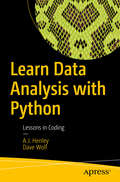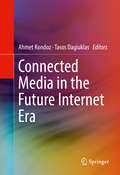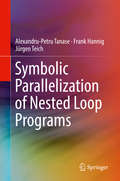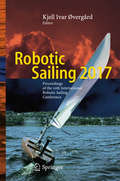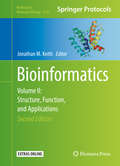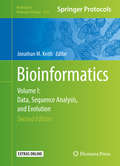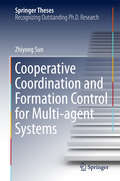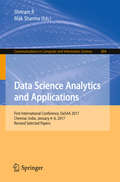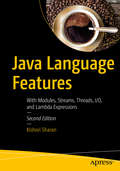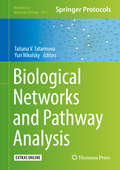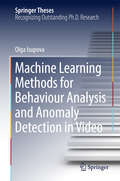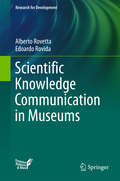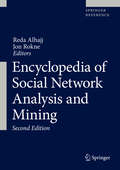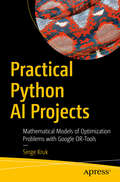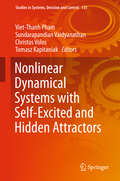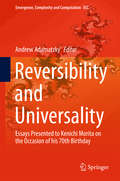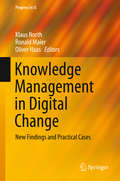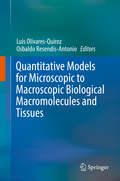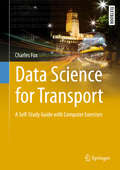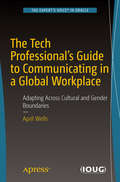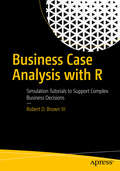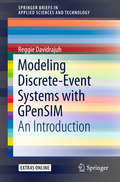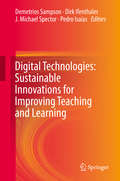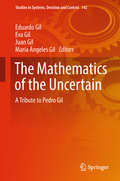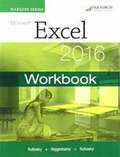- Table View
- List View
Learn Data Analysis with Python: Lessons In Coding
by A. J. Henley Dave WolfGet started using Python in data analysis with this compact practical guide. This book includes three exercises and a case study on getting data in and out of Python code in the right format. Learn Data Analysis with Python also helps you discover meaning in the data using analysis and shows you how to visualize it. Each lesson is, as much as possible, self-contained to allow you to dip in and out of the examples as your needs dictate. If you are already using Python for data analysis, you will find a number of things that you wish you knew how to do in Python. You can then take these techniques and apply them directly to your own projects.If you aren’t using Python for data analysis, this book takes you through the basics at the beginning to give you a solid foundation in the topic. As you work your way through the book you will have a better of idea of how to use Python for data analysis when you are finished.What You Will LearnGet data into and out of Python codePrepare the data and its formatFind the meaning of the dataVisualize the data using iPythonWho This Book Is For Those who want to learn data analysis using Python. Some experience with Python is recommended but not required, as is some prior experience with data analysis or data science.
Connected Media in the Future Internet Era
by Ahmet Kondoz Tasos DagiuklasThis book describes recent innovations in 3D media and technologies, with coverage of 3D media capturing, processing, encoding, and adaptation, networking aspects for 3D Media, and quality of user experience (QoE). The contributions are based on the results of the FP7 European Project ROMEO, which focuses on new methods for the compression and delivery of 3D multi-view video and spatial audio, as well as the optimization of networking and compression jointly across the future Internet. The delivery of 3D media to individual users remains a highly challenging problem due to the large amount of data involved, diverse network characteristics and user terminal requirements, as well as the user's context such as their preferences and location. As the number of visual views increases, current systems will struggle to meet the demanding requirements in terms of delivery of consistent video quality to fixed and mobile users. ROMEO will present hybrid networking solutions that combine the DVB-T2 and DVB-NGH broadcast access network technologies together with a QoE aware Peer-to-Peer (P2P) distribution system that operates over wired and wireless links. Live streaming 3D media needs to be received by collaborating users at the same time or with imperceptible delay to enable them to watch together while exchanging comments as if they were all in the same location. This book is the last of a series of three annual volumes devoted to the latest results of the FP7 European Project ROMEO. The present volume provides state-of-the-art information on 3D multi-view video, spatial audio networking protocols for 3D media, P2P 3D media streaming, and 3D Media delivery across heterogeneous wireless networks among other topics. Graduate students and professionals in electrical engineering and computer science with an interest in 3D Future Internet Media will find this volume to be essential reading.
Symbolic Parallelization of Nested Loop Programs
by Alexandru-Petru Tanase Frank Hannig Jürgen TeichThis book introduces new compilation techniques, using the polyhedron model for the resource-adaptive parallel execution of loop programs on massively parallel processor arrays. The authors show how to compute optimal symbolic assignments and parallel schedules of loop iterations at compile time, for cases where the number of available cores becomes known only at runtime. The compile/runtime symbolic parallelization approach the authors describe reduces significantly the runtime overhead, compared to dynamic or just‐in-time compilation. The new, on‐demand fault‐tolerant loop processing approach described in this book protects loop nests for parallel execution against soft errors.
Robotic Sailing 2017
by Kjell Ivar ØvergårdRobotic Sailing 2017. This book contains the peer-reviewed papers presented at the 10th International Robotic Sailing Conference which was organized in conjunction with the 10th World Robotic Sailing Championship held in Horten, Norway the 4th-9th of September 2017. The seven papers cover topics of interest for autonomous robotic sailing which represents some of the most challenging research and development areas. The book is divided into two parts. The first part contains papers which focus on the design of sails and software for the assessment and predication of sailboat performance as well as software platforms and middleware for sailboat competition and research. The second part includes algorithms and strategies for navigation and collision avoidance on local, mid- and long range. The differences in approach in the included papers show that robotic sailing is still an emerging cross-disciplinary science. The multitude of suggestions to the specific problems of prediction and simulation of sailboats as well as the challenges of route planning, anti-grounding and collision avoidance are good indicators of science in its infancy. Hence, we may expect the future to hold great advances for robotic sailing.
Bioinformatics: Volume II: Structure, Function, and Applications (Methods in Molecular Biology #1526)
by Jonathan M. KeithIn Bioinformatics, leading researchers provide a selection of the most useful and widely applicable methods, able to be applied as is, or with minor variations, to many specific problems. Volume II: Structure, Function and Applications contains methods pertinent to the prediction of protein and RNA structures and the analysis and classification of structures, methods for inferring the function of previously identified genomic elements, chiefly protein-coding genes, medical applications in diagnostics and drug discovery, and "meta-methods" for developers of bioinformatics algorithms. Over 80 authors from around the globe have contributed to the two volumes.
Bioinformatics: Volume I: Data, Sequence Analysis, and Evolution (Methods in Molecular Biology #1525)
by Jonathan M. KeithIn Bioinformatics, leading researchers provide a selection of the most useful and widely applicable methods, able to be applied as is, or with minor variations, to many specific problems. Volume II: Structure, Function and Applications contains methods pertinent to the prediction of protein and RNA structures and the analysis and classification of structures, methods for inferring the function of previously identified genomic elements, chiefly protein-coding genes, medical applications in diagnostics and drug discovery, and "meta-methods" for developers of bioinformatics algorithms. Over 80 authors from around the globe have contributed to the two volumes.
Cooperative Coordination and Formation Control for Multi-agent Systems (Springer Theses)
by Zhiyong SunThe thesis presents new results on multi-agent formation control, focusing on the distributed stabilization control of rigid formation shapes. It analyzes a range of current research problems such as problems concerning the equilibrium and stability of formation control systems, or the problem of cooperative coordination control when agents have general dynamical models, and discusses practical considerations arising during the implementation of established formation control algorithms. In addition, the thesis presents models of increasing complexity, from single integrator models, to double integrator models, to agents modeled by nonlinear kinematic and dynamic equations, including the familiar unicycle model and nonlinear system equations with drift terms. Presenting the fruits of a close collaboration between several top control groups at leading universities including Yale University, Groningen University, Purdue University and Gwangju Institute of Science and Technology (GIST), the thesis spans various research areas, including robustness issues in formations, quantization-based coordination, exponential stability in formation systems, and cooperative coordination of networked heterogeneous systems.
Data Science Analytics and Applications: First International Conference, Dasaa 2017, Chennai, India, January 4-6, 2017, Revised Selected Papers (Communications In Computer And Information Science #804)
by Shriram R Mak SharmaThis book constitutes the refereed proceedings of the First International Conference on Data Science Analytics and Applications, DaSAA 2017, held in Chennai, India, in January 2017. The 16 revised full papers and 4 revised short papers presented were carefully reviewed and selected from 77 submissions. The papers address issues such as data analytics, data mining, cloud computing, machine learning, text classification and analysis, information retrieval, DSS, security, image and video processing.
Java Language Features: Lambda Expressions, Inner Classes, Threads, I/o And Collections
by Kishori SharanWork with essential and advanced features of the Java programming language such as Java modules development, lambda expressions (closures), inner classes, threads, I/O, Collections, garbage collection, and more. Author Kishori Sharan provides over 50 diagrams and 290 complete programs to help you visualize and better understand the topics covered in this book.Java Language Features, Second Edition starts with a series of chapters on the essential language features provided by Java, including annotations, reflection, and generics. These topics are then complemented by details of how to use lambda expressions, allowing you to build powerful and efficient Java programs. The chapter on threads follows this up and discusses everything from the very basic concepts of a thread to the most advanced topics such as synchronizers, the fork/join framework, and atomic variables.This book contains unmatched coverage of Java NIO, the Stream API, the Path API, the FileVisitor API, the watch service, and asynchronous file I/O. With this in-depth knowledge, your data- and file-management programs will be able to take advantage of every feature of Java's powerful I/O framework and much more.Additionally, three appendices are available for free via the Download Source Code on apress.com. These appendices will give you a head start on the most important features of Java 10 and the new Java versioning scheme.What You’ll LearnUse essential and advanced features of the Java languageCode Java annotations and inner classesWork with reflection, generics, and threadsTake advantage of the garbage collectorManage streams with the Stream APIWho This Book Is ForThose new to Java programming and continues the learning Java journey; it is recommended that you read an introductory Java programming book first, such as Beginning Java Fundamentals, from Apress.
Biological Networks and Pathway Analysis (Methods in Molecular Biology #1613)
by Yuri Nikolsky Tatiana V. TatarinovaIn this volume, expert practitioners present a compilation of methods of functional data analysis (often referred to as "systems biology") and its applications in drug discovery, medicine, and basic disease research. It covers such important issues as the elucidation of protein, compound and gene interactions, as well as analytical tools, including networks, interactome and ontologies, and clinical applications of functional analysis. As a volume in the highly successful Methods in Molecular Biology series, this work provides detailed description and hands-on implementation advice. Reputable, comprehensive, and cutting-edge, Biological Networks and Pathway Analysis presents both "wet lab" experimental methods and computational tools in order to cover a broad spectrum of issues in this fascinating new field.
Machine Learning Methods for Behaviour Analysis and Anomaly Detection in Video (Springer Theses)
by Olga IsupovaThis thesis proposes machine learning methods for understanding scenes via behaviour analysis and online anomaly detection in video. The book introduces novel Bayesian topic models for detection of events that are different from typical activities and a novel framework for change point detection for identifying sudden behavioural changes.Behaviour analysis and anomaly detection are key components of intelligent vision systems. Anomaly detection can be considered from two perspectives: abnormal events can be defined as those that violate typical activities or as a sudden change in behaviour. Topic modelling and change-point detection methodologies, respectively, are employed to achieve these objectives.The thesis starts with the development of learning algorithms for a dynamic topic model, which extract topics that represent typical activities of a scene. These typical activities are used in a normality measure in anomaly detection decision-making. The book also proposes a novel anomaly localisation procedure. In the first topic model presented, a number of topics should be specified in advance. A novel dynamic nonparametric hierarchical Dirichlet process topic model is then developed where the number of topics is determined from data. Batch and online inference algorithms are developed.The latter part of the thesis considers behaviour analysis and anomaly detection within the change-point detection methodology. A novel general framework for change-point detection is introduced. Gaussian process time series data is considered. Statistical hypothesis tests are proposed for both offline and online data processing and multiple change point detection are proposed and theoretical properties of the tests are derived. The thesis is accompanied by open-source toolboxes that can be used by researchers and engineers.
Scientific Knowledge Communication in Museums (Research For Development Ser.)
by Alberto Rovetta Edoardo RovidaThis book explains the general principles of scientific and technical communication in the context of modern museums. It also examines, with the aid of informative case studies, the different means by which knowledge can be transmitted, including posters, objects, explanatory guidance, documentation, and catalogues. Highlighting the ever more important role of multimedia and virtual reality components in communicating understanding of and facilitating interaction with the displayed object, it explores how network communications systems and algorithms can be applied to offer individual users the information that is most pertinent to them. The book is supported by a Dynamic Museums app connected to museum databases where series of objects can be viewed via cloud computing and the Internet and printed using 3D printing technology. This book is of interest to a diverse readership, including all those who are responsible for museums’ collections, operations, and communications as well as those delivering or participating in courses on museums and their use, communication design and related topics.
Encyclopedia of Social Network Analysis and Mining
by Reda Alhajj Jon RokneSocial Network Analysis and Mining Encyclopedia (ESNAM) is the first major reference work to integrate fundamental concepts and research directions in the areas of social networks and applications to data mining. The second edition of ESNAM is a truly outstanding reference appealing to researchers, practitioners, instructors and students (both undergraduate and graduate), as well as the general public. This updated reference integrates all basics concepts and research efforts under one umbrella. Coverage has been expanded to include new emerging topics such as crowdsourcing, opinion mining, and sentiment analysis. Revised content of existing material keeps the encyclopedia current. The second edition is intended for college students as well as public and academic libraries. It is anticipated to continue to stimulate more awareness of social network applications and research efforts.The advent of electronic communication, and in particular on-line communities, have created social networks of hitherto unimaginable sizes. Reflecting the interdisciplinary nature of this unique field, the essential contributions of diverse disciplines, from computer science, mathematics, and statistics to sociology and behavioral science, are described among the 300 authoritative yet highly readable entries. Students will find a world of information and insight behind the familiar façade of the social networks in which they participate. Researchers and practitioners will benefit from a comprehensive perspective on the methodologies for analysis of constructed networks, and the data mining and machine learning techniques that have proved attractive for sophisticated knowledge discovery in complex applications. Also addressed is the application of social network methodologies to other domains, such as web networks and biological networks.
Practical Python AI Projects: Mathematical Models Of Optimization Problems With Google Or-tools
by Serge KrukDiscover the art and science of solving artificial intelligence problems with Python using optimization modeling. This book covers the practical creation and analysis of mathematical algebraic models such as linear continuous models, non-obviously linear continuous models,and pure linear integer models. Rather than focus on theory, Practical Python AI Projects, the product of the author's decades of industry teaching and consulting, stresses the model creation aspect; contrasting alternate approaches and practical variations.Each model is explained thoroughly and written to be executed. The source code from all examples in the book is available, written in Python using Google OR-Tools. It also includes a random problem generator, useful for industry application or study.What You Will LearnBuild basic Python-based artificial intelligence (AI) applications Work with mathematical optimization methods and the Google OR-Tools (Optimization Tools) suiteCreate several types of projects using Python and Google OR-ToolsWho This Book Is ForDevelopers and students who already have prior experience in Python coding. Some prior mathematical experience or comfort level may be helpful as well.
Nonlinear Dynamical Systems with Self-Excited and Hidden Attractors (Studies In Systems, Decision And Control #133)
by Viet-Thanh Pham Sundarapandian Vaidyanathan Christos Volos Tomasz KapitaniakThis book highlights the latest findings on nonlinear dynamical systems including two types of attractors: self-excited and hidden attractors. Further, it presents both theoretical and practical approaches to investigating nonlinear dynamical systems with self-excited and hidden attractors. The book includes 20 chapters contributed by respected experts, which focus on various applications such as biological systems, memristor-based systems, fractional-order systems, finance systems, business cycles, oscillators, coupled systems, hyperchaotic systems, flexible robot manipulators, electronic circuits, and control models. Special attention is given to modeling, design, circuit realization, and practical applications to address recent research problems in nonlinear dynamical systems.The book provides a valuable reference guide to nonlinear dynamical systems for engineers, researchers, and graduate students, especially those whose work involves mechanics, electrical engineering, and control systems.
Reversibility and Universality: Essays Presented To Kenichi Morita On The Occasion Of His 70th Birthday (Emergence, Complexity And Computation Ser. #30)
by Andrew AdamatzkyThis book is a tribute to Kenichi Morita’s ideas and achievements in theoretical computer science, reversibility and computationally universal mathematical machines. It offers a unique source of information on universality and reversibility in computation and is an indispensable book for computer scientists, mathematicians, physicists and engineers. Morita is renowned for his works on two-dimensional language accepting automata, complexity of Turing machines, universality of cellular automata, regular and context-free array grammars, and undecidability. His high-impact works include findings on parallel generation and parsing of array languages by means of reversible automata, construction of a reversible automaton from Fredkin gates, solving a firing squad synchronization problem in reversible cellular automata, self-reproduction in reversible cellular spaces, universal reversible two-counter machines, solution of nondeterministic polynomial (NP) problems in hyperbolic cellular automata, reversible P-systems, a new universal reversible logic element with memory, and reversibility in asynchronous cellular automata.Kenichi Morita’s achievements in reversibility, universality and theory of computation are celebrated in over twenty high-profile contributions from his colleagues, collaborators, students and friends. The theoretical constructs presented in this book are amazing in their diversity and depth of intellectual insight, addressing: queue automata, hyperbolic cellular automata, Abelian invertible automata, number-conserving cellular automata, Brownian circuits, chemical automata, logical gates implemented via glider collisions, computation in swarm networks, picture arrays, universal reversible counter machines, input-position-restricted models of language acceptors, descriptional complexity and persistence of cellular automata, partitioned cellular automata, firing squad synchronization algorithms, reversible asynchronous automata, reversible simulations of ranking trees, Shor’s factorization algorithms, and power consumption of cellular automata.
Knowledge Management in Digital Change: New Findings And Practical Cases (Progress in IS)
by Klaus North Ronald Maier Oliver HaasThis book features both cutting-edge contributions on managing knowledge in transformational contexts and a selection of real-world case studies. It analyzes how the disruptive power of digitization is becoming a major challenge for knowledge-based value creation worldwide, and subsequently examines the changes in how we manage information and knowledge, communicate, collaborate, learn and decide within and across organizations. The book highlights the opportunities provided by disruptive renewal, while also stressing the need for knowledge workers and organizations to transform governance, leadership and work organization. Emerging new business models and digitally enabled co-creation are presented as drivers that can help establish new ways of managing knowledge. In turn, a number of carefully selected and interpreted case studies provide a link to practice in organizations.
Quantitative Models for Microscopic to Macroscopic Biological Macromolecules and Tissues
by Luis Olivares-Quiroz Osbaldo Resendis-AntonioThis book presents cutting-edge research on the use of physical and mathematical formalisms to model and quantitatively analyze biological phenomena ranging from microscopic to macroscopic systems. The systems discussed in this compilation cover protein folding pathways, gene regulation in prostate cancer, quorum sensing in bacteria to mathematical and physical descriptions to analyze anomalous diffusion in patchy environments and the physical mechanisms that drive active motion in large sets of particles, both fundamental descriptions that can be applied to different phenomena in biology. All chapters are written by well-known experts on their respective research fields with a vast amount of scientific discussion and references in order the interested reader can pursue a further reading. Given these features, we consider Quantitative Models for Microscopic to Macroscopic Biological Macromolecules and Tissues as an excellent and up-to-date resource and reference for advanced undergraduate students, graduate students and junior researchers interested in the latest developments at the intersection of physics, mathematics, molecular biology, and computational sciences. Such research field, without hesitation, is one of the most interesting, challenging and active of this century and the next.
Data Science for Transport: A Self-study Guide With Computer Exercises (Springer Textbooks In Earth Sciences, Geography And Environment Ser.)
by Charles FoxThe quantity, diversity and availability of transport data is increasing rapidly, requiring new skills in the management and interrogation of data and databases. Recent years have seen a new wave of 'big data', 'Data Science', and 'smart cities' changing the world, with the Harvard Business Review describing Data Science as the "sexiest job of the 21st century". Transportation professionals and researchers need to be able to use data and databases in order to establish quantitative, empirical facts, and to validate and challenge their mathematical models, whose axioms have traditionally often been assumed rather than rigorously tested against data. This book takes a highly practical approach to learning about Data Science tools and their application to investigating transport issues. The focus is principally on practical, professional work with real data and tools, including business and ethical issues."Transport modeling practice was developed in a data poor world, and many of our current techniques and skills are building on that sparsity. In a new data rich world, the required tools are different and the ethical questions around data and privacy are definitely different. I am not sure whether current professionals have these skills; and I am certainly not convinced that our current transport modeling tools will survive in a data rich environment. This is an exciting time to be a data scientist in the transport field. We are trying to get to grips with the opportunities that big data sources offer; but at the same time such data skills need to be fused with an understanding of transport, and of transport modeling. Those with these combined skills can be instrumental at providing better, faster, cheaper data for transport decision- making; and ultimately contribute to innovative, efficient, data driven modeling techniques of the future. It is not surprising that this course, this book, has been authored by the Institute for Transport Studies. To do this well, you need a blend of academic rigor and practical pragmatism. There are few educational or research establishments better equipped to do that than ITS Leeds". - Tom van Vuren, Divisional Director, Mott MacDonald"WSP is proud to be a thought leader in the world of transport modelling, planning and economics, and has a wide range of opportunities for people with skills in these areas. The evidence base and forecasts we deliver to effectively implement strategies and schemes are ever more data and technology focused a trend we have helped shape since the 1970's, but with particular disruption and opportunity in recent years. As a result of these trends, and to suitably skill the next generation of transport modellers, we asked the world-leading Institute for Transport Studies, to boost skills in these areas, and they have responded with a new MSc programme which you too can now study via this book." - Leighton Cardwell, Technical Director, WSP."From processing and analysing large datasets, to automation of modelling tasks sometimes requiring different software packages to "talk" to each other, to data visualization, SYSTRA employs a range of techniques and tools to provide our clients with deeper insights and effective solutions. This book does an excellent job in giving you the skills to manage, interrogate and analyse databases, and develop powerful presentations. Another important publication from ITS Leeds." - Fitsum Teklu, Associate Director (Modelling & Appraisal) SYSTRA Ltd"Urban planning has relied for decades on statistical and computational practices that have little to do with mainstream data science. Information is still often used as evidence on the impact of new infrastructure even when it hardly contains any valid evidence. This book is an extremely welcome effort to provide young professionals with the skills needed to analyse how cities and transport networks actually work. The book is also highly relevant to anyone who will later want to build digital solutions to optimise urban travel based on emerging data sources". - Yaron Hollander, author of "T
The Tech Professional's Guide to Communicating in a Global Workplace: Adapting Across Cultural And Gender Boundaries
by April WellsInformation technologists are increasingly being made part of global teams, and are confronting the challenges of communicating across a variety of linguistic and cultural boundaries. This book helps you know what to say, what not to say, and even where to sit in meetings and in social situations.The Tech Professional's Guide to Communicating in a Global Workplace shows you how to effectively communicate across a variety of different cultures within and across organizations. You will become aware of cultural differences from one country or region to another, between various groups at the local level, and across groups such as developers to DBAs, IT staff to business people, women to men, people approaching retirement to people coming into the organization fresh out of college, and more. The author provides her personal experiences and shares anecdotes as well as lessons learned, key takeaways, and references for further reading. Whether it is face to face, over the phone, via email or instant messenger, or in a presentation, meeting, or report, the ability to communicate effectively is critical.What You'll LearnConcisely communicate with the right audience in the right wayWrite emails that are understood and get the results you wantImprove personal reputation as an effective communicatorCommunicate across cultural boundaries without offendingPresent the desired impression in business situationsGrow professionally by adjusting your communication styleWho This Book Is ForProgrammers and system administrators, including database administrators
Business Case Analysis with R: Simulation Tutorials To Support Complex Business Decisions
by Robert D. Brown IIIThis tutorial teaches you how to use the statistical programming language R to develop a business case simulation and analysis. It presents a methodology for conducting business case analysis that minimizes decision delay by focusing stakeholders on what matters most and suggests pathways for minimizing the risk in strategic and capital allocation decisions. Business case analysis, often conducted in spreadsheets, exposes decision makers to additional risks that arise just from the use of the spreadsheet environment. R has become one of the most widely used tools for reproducible quantitative analysis, and analysts fluent in this language are in high demand. The R language, traditionally used for statistical analysis, provides a more explicit, flexible, and extensible environment than spreadsheets for conducting business case analysis. The main tutorial follows the case in which a chemical manufacturing company considers constructing a chemical reactor and production facility to bring a new compound to market. There are numerous uncertainties and risks involved, including the possibility that a competitor brings a similar product online. The company must determine the value of making the decision to move forward and where they might prioritize their attention to make a more informed and robust decision. While the example used is a chemical company, the analysis structure it presents can be applied to just about any business decision, from IT projects to new product development to commercial real estate. The supporting tutorials include the perspective of the founder of a professional service firm who wants to grow his business and a member of a strategic planning group in a biomedical device company who wants to know how much to budget in order to refine the quality of information about critical uncertainties that might affect the value of a chosen product development pathway. What You’ll LearnSet up a business case abstraction in an influence diagram to communicate the essence of the problem to other stakeholdersModel the inherent uncertainties in the problem with Monte Carlo simulation using the R languageCommunicate the results graphicallyDraw appropriate insights from the resultsDevelop creative decision strategies for thorough opportunity cost analysisCalculate the value of information on critical uncertainties between competing decision strategies to set the budget for deeper data analysisConstruct appropriate information to satisfy the parameters for the Monte Carlo simulation when little or no empirical data are available Who This Book Is For Financial analysts, data practitioners, and risk/business professionals; also appropriate for graduate level finance, business, or data science students
Modeling Discrete-Event Systems with GPenSIM: An Introduction (SpringerBriefs in Applied Sciences and Technology)
by Reggie DavidrajuhModeling Discrete-Event Systems with GPenSIM describes the design and applications of General Purpose Petri Net Simulator (GPenSIM), which is a software tool for modeling, simulation, and performance analysis of discrete-event systems. The brief explains the principles of modelling discrete-event systems, as well as the design and applications of GPenSIM. It is based on the author’s lectures that were given on “modeling, simulation, and performance analysis of discrete event systems”. The brief uses GPenSIM to enable the efficient modeling of complex and large-scale discrete-event systems. GPenSIM, which is based on MATLAB®, is designed to allow easy integration of Petri net models with a vast number of toolboxes that are available on the MATLAB®. The book offers an approach for developing models that can interact with the external environment; this will help readers to solve problems in industrial diverse fields. These problems include:airport capacity evaluation for aviation authorities;finding bottlenecks in supply chains;scheduling drilling operations in the oil and gas industry; andoptimal scheduling of jobs in grid computing. This brief is of interest to researchers working on the modeling, simulation and performance evaluation of discrete-event systems, as it shows them the design and applications of an efficient modeling package. Since the book also explains the basic principles of modeling discrete-event systems in a step-by-step manner, it is also of interest to final-year undergraduate and postgraduate students.
Digital Technologies: Sustainable Innovations for Improving Teaching and Learning
by Demetrios Sampson Dirk Ifenthaler J. Michael Spector Pedro IsaíasThe aim of this volume entitled Digital Technologies: Sustainable Innovations for improving Teaching and Learning is to contribute in the global discussion on digital technologies as the means to foster sustainable educational innovations for improving the teaching, learning and assessment from K-12 to Higher Education. It compiles papers presented at the CELDA (Cognition and Exploratory Learning in the Digital Age) conference, which has as its goal continuing to address these challenges and promote the effective use of new tools and technologies to support teaching, learning and assessment. The book consists of four parts and showcases how emerging educational technologies and innovative practices have been used to address core global educational challenges; spanning from rethinking and transforming learning environments across educational contexts to effectively cultivating students’ competences for the digital smart society of the future. The book comprises Part I: Transforming the Learning Environment; Part II: Enriching student learning experiences; Part III: Measuring and Assessing Teaching and Learning with Educational Data Analytics; Part IV: Cultivating student competences for the digital Smart society. It targets researchers and research students, educational professional practitioners (including teachers, educators and education leaders) as well as education policy makers, who are interested in keeping up-to-date on the global development in this field.
The Mathematics of the Uncertain: A Tribute To Pedro Gil (Studies In Systems, Decision And Control #142)
by Eduardo Gil Eva Gil Juan Gil María Ángeles GilThis book is a tribute to Professor Pedro Gil, who created the Department of Statistics, OR and TM at the University of Oviedo, and a former President of the Spanish Society of Statistics and OR (SEIO). In more than eighty original contributions, it illustrates the extent to which Mathematics can help manage uncertainty, a factor that is inherent to real life. Today it goes without saying that, in order to model experiments and systems and to analyze related outcomes and data, it is necessary to consider formal ideas and develop scientific approaches and techniques for dealing with uncertainty. Mathematics is crucial in this endeavor, as this book demonstrates. As Professor Pedro Gil highlighted twenty years ago, there are several well-known mathematical branches for this purpose, including Mathematics of chance (Probability and Statistics),Mathematics of communication (Information Theory), andMathematics of imprecision (Fuzzy Sets Theory and others).These branches often intertwine, since different sources of uncertainty can coexist, and they are not exhaustive. While most of the papers presented here address the three aforementioned fields, some hail from other Mathematical disciplines such as Operations Research; others, in turn, put the spotlight on real-world studies and applications. The intended audience of this book is mainly statisticians, mathematicians and computer scientists, but practitioners in these areas will certainly also find the book a very interesting read.
Microsoft® Excel® 2016 Workbook (Marquee Series)
by Nita Rutkosky Audrey Roggenkamp Ian RutkoskyMarquee Series: Microsoft Excel 2016 offers a highly visual, hands-on approach to learning Microsoft Excel. Ideal for 1 or 2 credit courses, this text facilitates self-paced, accelerated, and traditional learning formats.
